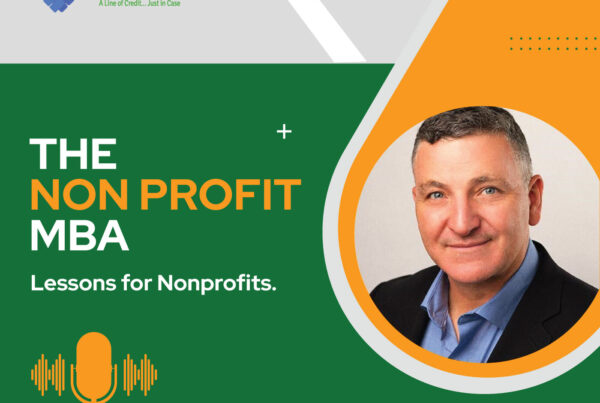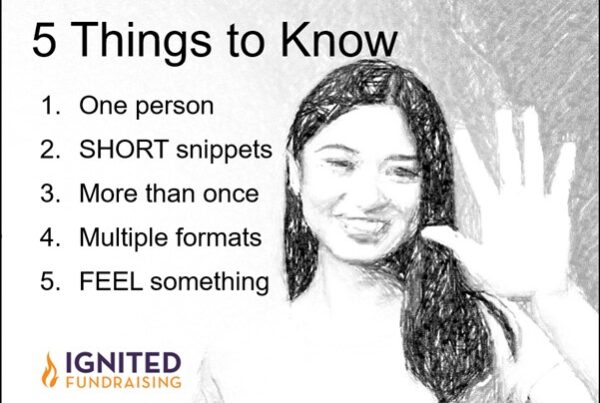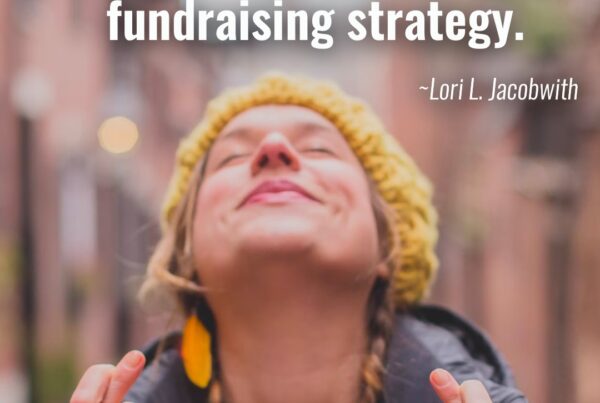You are busy. I know you are. Me too. And so when people talk to you about staying in touch with your key supporters you roll your eyes or breathe that heavy sigh of the overwhelmed and think, “Who has time to do that? Not me!”
The key is to look at donor communication as part of the foundation of how your organization is supported. You have to ask for the gift. You have to tell what it’s for. And, for sure, you have to create emotionally engaging relevance with your community.
Start with your major donors. But first you have to be clear HOW you define major donor. Is it $500+ gifts? $1000+ gifts or even higher?

Then with your fund development team (usually this consists of your board chair, your executive director, your development director, and a couple others – either board members or community volunteers) ask your team: Do we know the names and faces of all of our top 25-50 major donors?
If you know them all and could pick them out in a line-up at the next gala or golf event. Great! If not, then start making plans to learn who they are.
Then you’ll need a plan.
I believe that plan has to focus on what you say, how you listen, and who is helping you stay connected to your top donors. Keep that communication crisp and clear, and cause me to feel something about what you are sharing.
Six areas of focus for causing irresistible connections with your supporters:
- Know your top donors. Really know them and why they give to you. Be authentic with them. Talk to them AND listen to them. When is the last time you listened for longer than a few seconds to a long-time donor?
- Utilize your team.
You don’t think you have a team? Sure you do. It’s your board. The other staff, even the program staff, current donors, former board members, and other key volunteers. Give them something specific to do like learn one thing about a specific guest or two at the gala or the fundraising luncheon. - Be clear about the message.
What is the impact of a financial gift to your organization? Share real life stories about how someone’s life is better because of your program AND their gift. Ask your donors for THEIR stories about why they give or how it feels to make a contribution to your organization. - Use business as usual events to engage. How many donors do you talk to in a week? How many visit your pre-school program graduation ceremony? Or how many donors have seen the hubbub of packing up to deliver meals to the elderly? Or the patience it takes to train that new guide dog? Designate just a few minutes a week as the engagement time when the 3 – 5 donors you phoned can stop by and see their gifts in action at some event that you always do. Nothing special or costly here. Just business as usual events.
- Use multi-channel fundraising to engage. There has been lots written about this but the important thing is to not assume I’m reading everything you send me, so share with me the same message multiple ways at different times. And when you do use social media tools always provide something of value and say something that causes people to feel something.
- Use your database. I can’t say enough about keeping track of communication in your donor tracking system. Keep track of phone calls, messages left, mailings sent, emails opened. And not just by you, by anyone in your organization. That way you can really see if you are “over-communicating” or if someone else has already been in touch with that special donor this week.
The key is to create an environment that causes a supporter to choose to stay connected to you even when they are busy and don’t feel like they have the time to come to the next event or read the next newsletter.
This post is a recap of the webinar session I recently delivered for Gail Perry’s Fired up Fundraisers. Thanks, Gail for allowing me to talk with your group!






